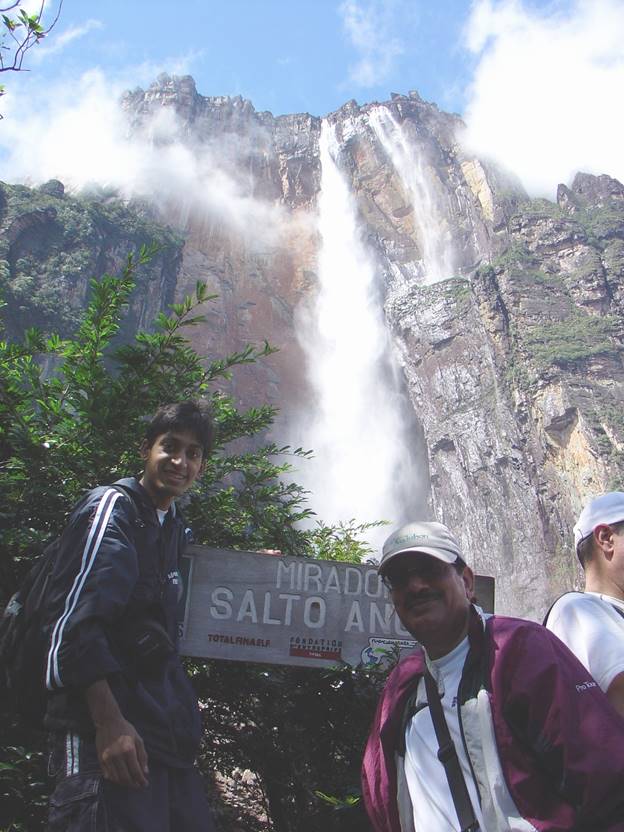
Visiting Angel Falls: The Most Challenging Physical Experience
By Khalid Siddiqui
Ohio

I have been asked several times to name my most physically challenging travel experience. Indisputably, visiting the Angel’s Falls in Venezuela remains at the top of my list with Antarctica a close second. This article is about Angel Falls, and the hardships I had to face reaching it.
There are three major waterfalls in the world: Victoria Falls, Zambia/Zimbabwe – the widest; Iguazu Falls, Brazil/Argentina – the most massive by the volume of water discharged; and Angel Falls, Venezuela – the highest or tallest. Having seen the first two I decided to see Angel Falls to complete the set.
Angel Falls is nestled deep in the Gran Sabana Region of the Bolivar state of southeastern Venezuela, about 450 miles from Caracas, the capital. There are no roads to get to the Falls. Numerous table-top mountains or mesa, called “tepui” in the Pemon language of the indigenous people who inhabit that area, are found in this region. The Kerepakupai River flows over one of these mountains called Auyan-tepui (“Devils Mountain”) in the Canaima National Park. The river drops over the edge of this table-mountain. The falling water forms the Churun River which is a tributary of the Carrao River.
Angel Falls is called kerepakupai-meru in the Pemon language, which means “falls from the deepest place”. It is the world's tallest uninterrupted waterfall, with a height of 979 meters (3,212 ft). To compare, the Horseshoe Falls of Niagara Falls is only 167 feet high. During the dry season (December to March), the volume of water is less than in other months.
The Falls were named after the American pilot, Jimmie Angel, who in 1937 managed to land his small plane on top of the mountain. However, the plane got stuck in the muddy terrain and could not take off. After a very difficult descent on foot which took them eleven days, Angel and his companions arrived exhausted at the valley of Kamarata. Angel died in Panama City, Panama, on December 8, 1956. His cremated remains were first interred at a shrine in Burbank, California, but in keeping with his wishes, his ashes were scattered over Angel Falls on July 2, 1960. Even though Angel is credited for having discovered the Falls, the honor actually belongs to Ernesto Sanchez, a retired officer of the Venezuelan Navy, who found it during his exploration of the area in 1910!
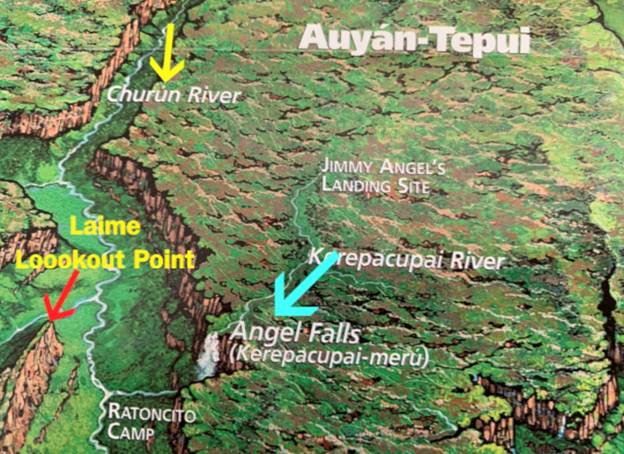
I, with my son, Sameer, left Cleveland, OH, early morning on December 31, 2004 for Miami. We took a connecting flight to Caracas, Venezuela, arriving there that evening. The next afternoon (January 1, 2005) we took a two-hour flight to Puerto Ordaz, arriving there at 5:20 pm. On January 2, 2005, we took a local flight on a small twin-propeller plane to Canaima National Park. The flight touched down in a landing strip near the Canaima Lagoon. From Canaima airstrip, we were driven to a lodge with several cabins for tourists.
There are two ways to see the Falls – by air and by boat. As a dense forest surrounds the Falls, it is best seen from the air. The river trips generally take place from June to December, when the rivers are deep enough for use by the Pemon guides. Both types of tours originate from Canaima.
The rest of that day (January 2) was spent on the beach enjoying several smaller waterfalls spilling into the Canaima Lagoon. Surprisingly, a medium-sized cloudy snail-eating snake appeared from nowhere just next to where we were sitting. That created some commotion.
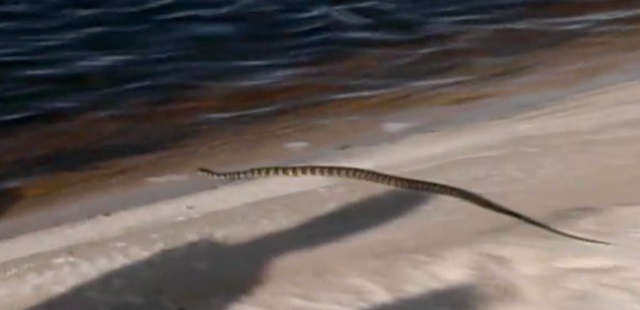
The snake appeared confused and moved randomly in every direction. Thankfully, it finally slithered into the water.
We had completed our third day in Venezuela and had reached, so far, only to the staging point. That evening, in the dining room of the lodge we met a French woman with her son. She was the wife of the First Officer at the French Embassy in Caracas, Venezuela. She was going to take a boat trip to view the Angel Falls the next morning. She warned us that the chances of seeing the Falls by a plane were very slim because the Falls almost always remained covered in clouds. That’s why she was taking the boat instead of the plane. My travel agent had also mentioned seeing the falls by the boat. Although, a sure shot, it would have been an arduous journey and would have taken the whole day. So, I decided to take a chance with the plane, but the discouraging information given by the French lady made me quite worried. The sightseeing flight to Angel Falls was scheduled for the next morning, January 3, 2005.
In the morning we arrived at the Canaima airstrip where we saw several small planes lined up on the tarmac. The tourists were assigned the planes on a first-come, first-served basis. Our group (I, my son and four other random tourists) were introduced to the pilot and assigned a plane. The planes carried 6 to 8 passengers and departed one at a time carrying the assigned load. They would wait on the tarmac until given a green signal from the control tower. The Falls are so high that most of the time they would remain covered in clouds or fog.
As soon as the pilot would be notified of clear skies above the Falls by the control tower, he would direct the tourists to board the plane quickly and take off. It usually took about ten minutes to reach the Falls. The plane would circle over the Falls for five minutes before flying away and landing on a small runway on the other side of the Falls. Usually, the clouds would return after fifteen minutes, so the window of opportunity for seeing the Falls was quite narrow.
When our turn came, the sky looked very clear but by the time we reached the Falls, it was completely covered with clouds.
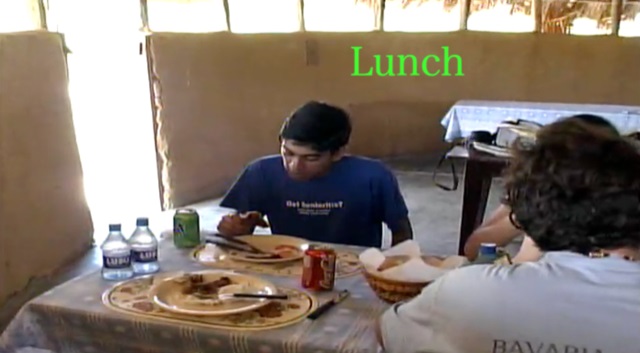
Lunch would be served at the smaller airport on the other side of the Falls. After lunch, the same process was repeated in the reverse order. So, each tourist would get two chances per day to have a look at the Falls.
Unfortunately, on our return flight to Canaima airport in the afternoon we again missed the Falls because of the clouds. So, after four days of traveling and waiting we still were not able to see the Falls. That was very depressing for us. On checking, I found out that most of the tourists were not able to see the Falls, as was predicted by the French lady.
So, if we really wanted to see the Falls, which we did, the only option left was to go by boat the next day. That created two problems. One was getting two seats in a boat leaving at 5:30 am the next morning; and the second problem was changing our itinerary because the next morning we were flying to start our bird-watching safari in the Orinoco Delta area. It was already late afternoon. I spoke with the manager of our lodge but he knew very little English. Fortunately, Sameer could speak Spanish very well, which was a great help. We were advised to see the supervisor of the tour company, Marie Garcia, to make any changes. Her office was in the other lodge. (The company owned two lodges.) The manager provided us with transportation. It was very hot and humid during the day but in the evening the temperature dropped. Marie’s office was nothing but an open tent. She was an indigenous Pemon woman. She was sitting in her office wearing a loose light-green top. We sat down across the desk from her. She opened her computer and started checking for any openings on the boat for the next morning.
All of a sudden I noticed some movement under her shirt. First, we ignored it, but the movements became more pronounced. We wondered what was going on. She suddenly yelled something in Spanish, and then put her hand under the shirt and pulled out a capuchin monkey from there. She did the same thing on the other side and pulled out another capuchin monkey. She said that they were her babies and that when they would get too rowdy she would put them on her breasts which calmed them down. The monkeys jumped around all over, and a few times landed on my shoulders also.
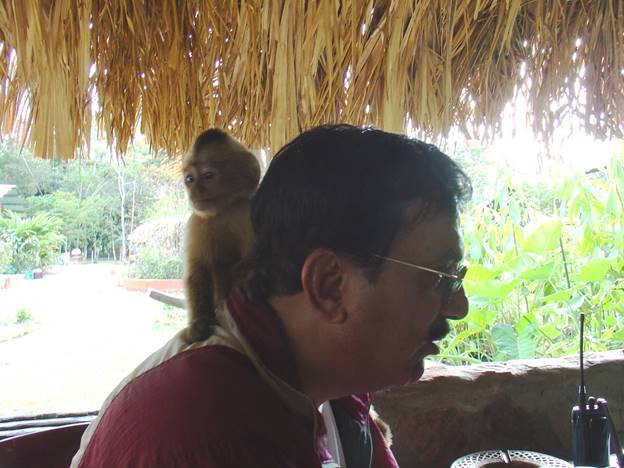
She said that she couldn’t give us any assurances until 9 pm that evening. She then led us out and arranged for transportation to our lodge. One of the monkeys was sitting on her left shoulder.

Again, with the help of Sameer, I was able to rearrange our itinerary. I was not happy to skip the Orinoco Delta which has been a famous spot for watching the water birds, but there was no choice. I also made reservations for the site-seeing plane ride for the Angel Falls next day just in case we didn’t get seats on the boat. However, Marie sent a message by 9 pm that two seats had been secured, and that we should be at the pier by 5:30 am. That was a big relief. It was advised to take as many water bottles as possible because it was going to be very hot and humid the next day. In the dining hall we met the French lady who had just returned from the boat ride. She was able to see the Falls but mentioned that the journey was very rough. I ignored her remark at that time. I had no idea what I was getting into.
The first thing I did the next morning (January 4) was to cancel our plane reservation for Angel Falls. It required lots of haggling because they insisted that it was non-refundable, but finally, they relented and returned the deposit. The boat excursion started at the Canaima Lagoon early in the morning. The area is very close to the equator, so the day is almost 12 hours long. The boat-ride was going to be six hours long. A look of the boat, in itself, raised my alarms. It was a curiara (a dug-out boat) with no roof. There were no chairs but bare wooden planks from front to back. There were no cushions or backrests.
The boat had no bathroom facilities. There were 12 people in the boat – two on each wooden bench. All the supporting staff as well as the driver of the boat and guide were indigenous Pemon. Leaving the lagoon, the boat entered the Carrao River. We were going upstream against the flow of the river. It was the beginning of the dry season (December to March) so the river was quite shallow. The riverbed consisted of stones of varying sizes. The experienced driver maneuvered the boat to keep it in the deepest parts of the river. However, at two points the river was so shallow that the boat’s bottom would hit the stones in the riverbed. So, the boat was taken to the shore to offload the passengers. He was then able to propel the boat across the shallow portion of the river. We walked along the shore, about 50 yards until the water was found to be deep enough for us to get inside the boat.
After two hours we stopped at Orchard Island to take breakfast. The breakfast area had a few chairs and tables under a rusty-tin roof. There were no facilities for warming the food or making tea. The whole area was an uninhabited jungle, and all the food items and cooking materials had to be brought on the boat from Canaima. After a brief stopover, the river journey continued.
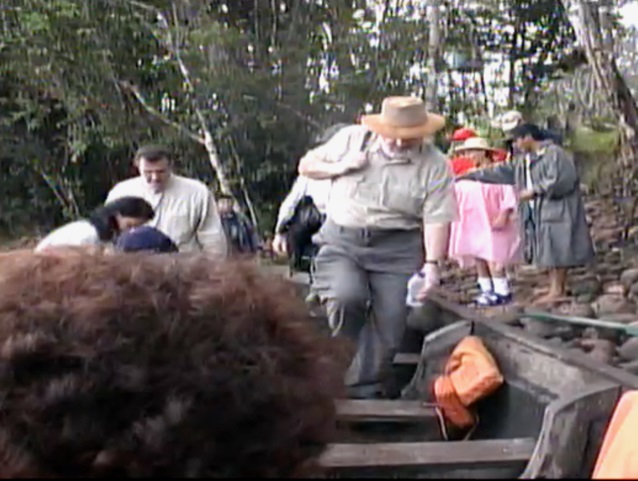
It became too hot and humid. We then figured out why they wanted us to bring lots of water bottles. Sitting on the bare hard wooden bench was becoming unbearable so we all took off our life-vests and used them as cushions. Some smart folks had brought their own cushions. The river slowly became deeper which helped the driver to navigate, but then the splashing water started coming inside the boat drenching the tourists. The boat left the Carrao River and entered one of its tributaries, the narrow Churun River. The high and impressive walls of the Auyan-tepui (Table Mountain) were sheltering the river from both sides. After six hours of miserable ride, we reached the camp at Isla Ratoncito (Little Mouse Island). It was decided to visit Angel Falls first before having lunch at Isla Ratoncito.
The best way to look at the Falls face-to-face and up close would be to climb up the hill behind the Ratoncito to the Laime Lookout Point. This would require walking up the hill for one hour in the hot and humid conditions through the thick rainforest growing on the mountain slopes. Many tourists were content with seeing the Falls from below rather than risking a fall climbing up. Surely, it was
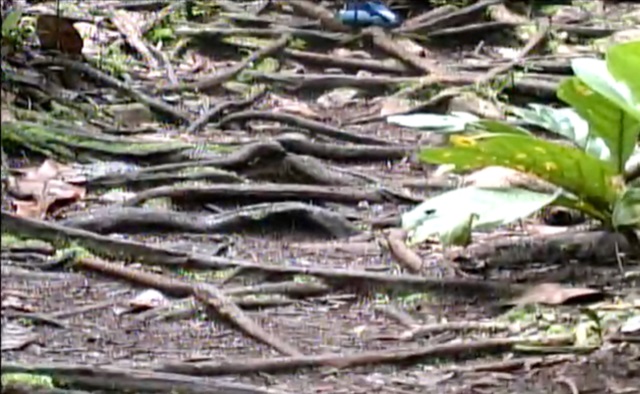
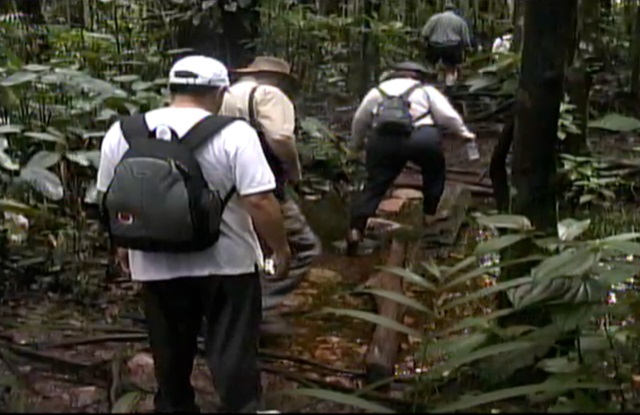
a very difficult climb. The ground was uneven, soggy, and muddy because the sunshine hardly ever penetrated the dense tree canopy to reach the floor of the forest. On the ground, amidst fallen leaves, small palms, heliconia, moss, lichens, mushrooms, and ferns were growing, thanks to the high level of humidity. The fallen leaves hid the nature of the soil underneath until someone stepped on it. The roots of the trees were spread superficially to extract nutrients from the soil, and were crisscrossing the trail. The older roots were covered with slippery green moss. One had to be careful not to trip over it. Some people did have non-serious falls.
Finally, we reached the Laime Lookout Point at the top of the mountain. There was no man-made structure there – no chairs, no benches, no roof. The people would sit on the floor or on the rocks scattered all over, and enjoy the majestic Falls at eye level just across the gorge. The long 980-meter high silver braid seemed to fall down from the sky. Falls are actually a series of small torrents jetting out of the mountain’s crevices, that mix up in the air. Behind the liquid screen, the reddish rocks of the Auyan-tepui could be seen. No doubt, most tourists get just a glimpse of the Falls from the air, but those who dare to visit it up close via this difficult route are well rewarded.
Watch the short video:
https://drive.google.com/file/d/1dZqKLedVPS5zX0pDhhRG-8zIYYm6WBQQ/view?usp=sharing
We stayed up there for fifteen minutes or so. Climbing down also took almost an hour. With no railings or ropes to hold on to, climbing down was more challenging with constant fear of falling. Some tourists who, most probably, were advised by the previous visitors had brought a cane with them which did help. We stopped at the camp in Isla Ratoncito for lunch. It also didn’t have any microwave oven to warm the food. We again had cold sandwiches. Then we boarded the boat for the dreaded return journey. The only consolation was that, as we were going downstream, it took only five hours that time.
We arrived at our lodge in Canaima Lagoon exhausted, but satisfied. So, it took five days from the time we left home to visit Angel Falls. It was worth it. We spent the next five days watching all sorts of birds and animals in many different reservations.

